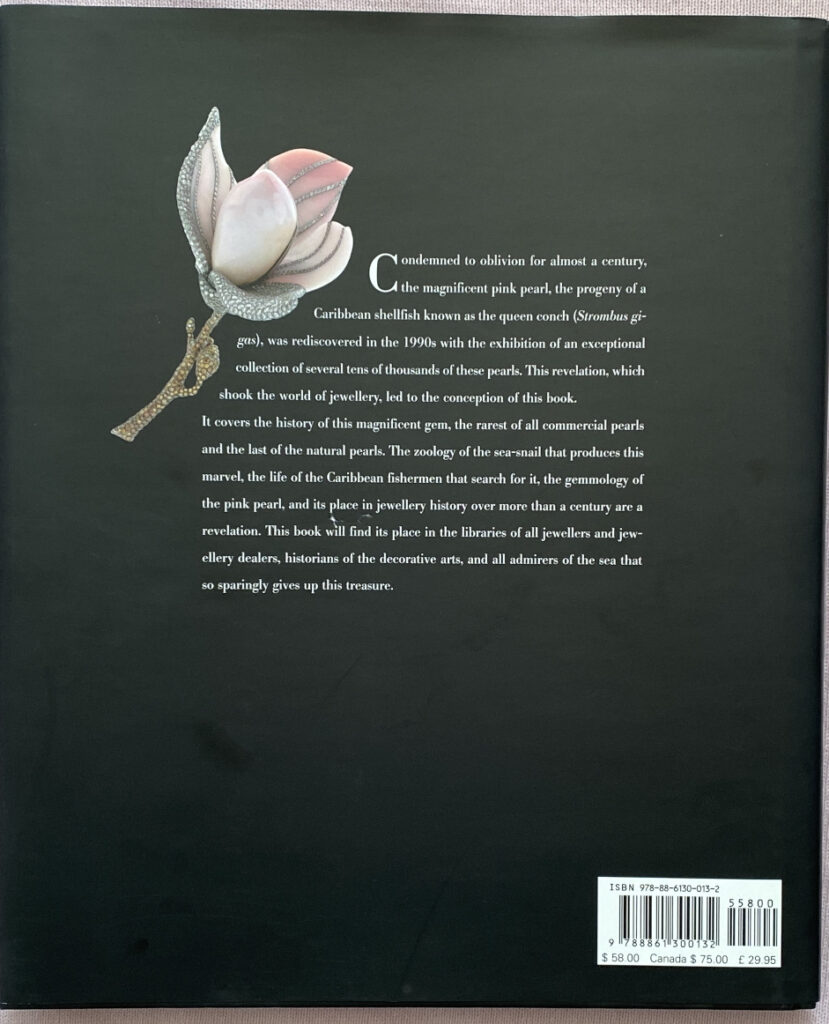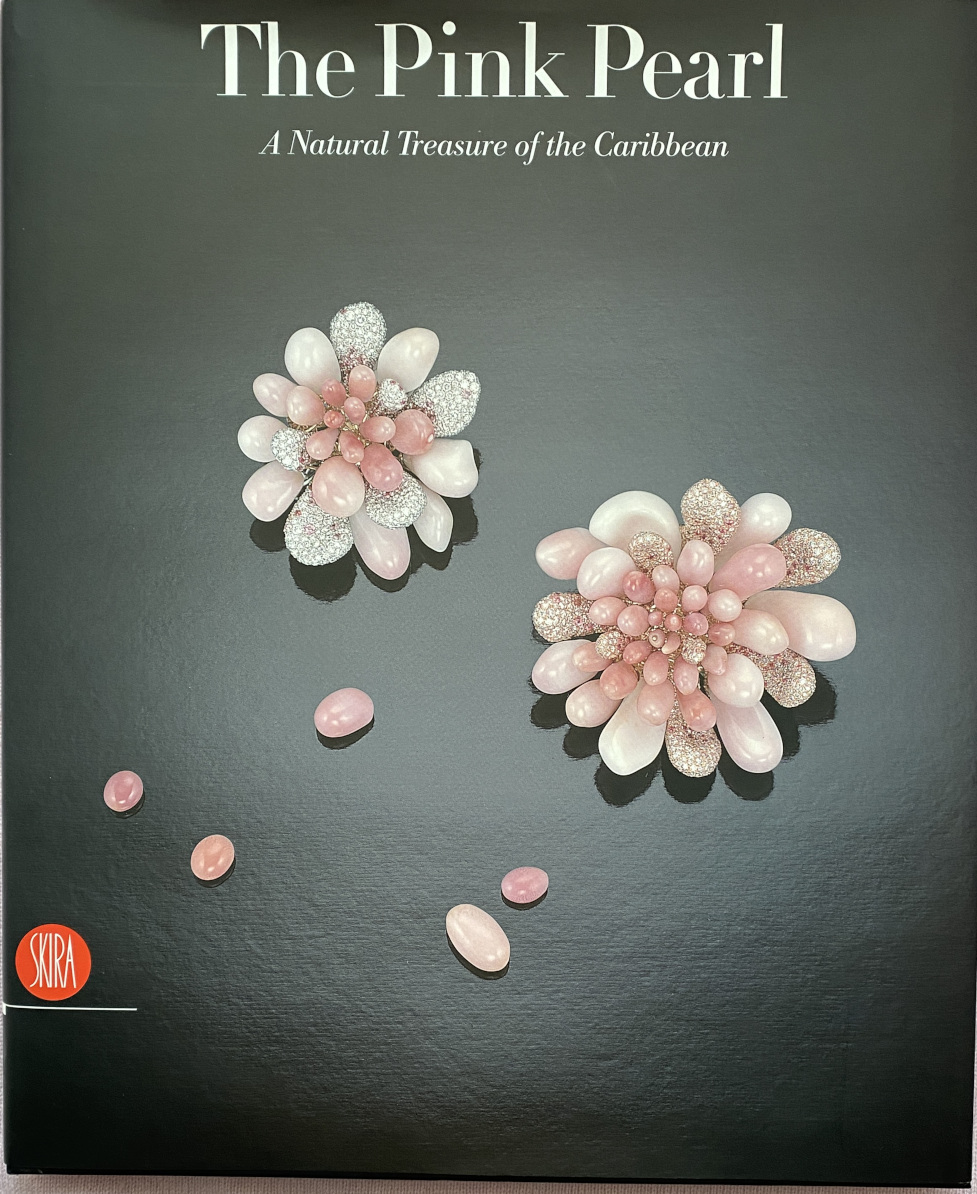Conch pearls are as elusive as they are beautiful. One of the very rare gems, there is not much common knowledge about them in books or in the internet. As there is no open market for the pearls, people do not know about them. Most of us cannot afford a real pink conch pearl, so there is no reason for traders to put information about them online to praise them.
In 2007 the beautiful book “The Pink Pearl – A Natural Treasure of the Caribbean” was published by Skira Editore in Italy. The book has centre stage here; to this day it is the only book covering conch pearls in full. It seems to be out of print now, which is a pity, as no newer version came after it. Quite a few illustrious names from the conch pearl industry were behind the book, giving their mysterious treasure a voice. As the conch pearl trade is done between a few organizations and individuals and the pearls end in high end jewellery for the lucky few, this glimpse in their world is exceptional.
Queen conch shells (Strombus Gigas) are native to the Caribbean, to the shallow water directly around the islands. They live in a depth of between 1 to 30 m. Their meat is a delicacy today as it was a few hundred years back. When one is lucky, one can get a salad made of fresh conch meat, onions, hot green peppers and lime juice directly on the islands. Alternatively it is served in a version of fried crab cakes.
The conch shell is the classical shell everyone thinks of when the Caribbean is mentioned. They are substantial, around 30 cm big and 2,5 kg heavy. Conchs are beautiful opening to the middle and displaying the colours of a sunset. They shimmer orange to rose and white. A conch shell is a souvenir, that many people bring proudly back home to remember their holidays.
Only 1 in 2 million of conch shells survives till adult age and of them there might be a natural pearl in 1 of 10.000. The pearls cannot be farmed, like all other pearls today. Every pearl found has been produced in the old-fashioned way of a foreign object, most probably a single grain of sand, intruding into the conch shell and getting slowly coated by calcium carbonate microcrystals. Conch pearls do not have the same nacre as other pearls, theirs is more porcelain like. The colours of the pearls are the full spectrum between white and pink. Conch pearls look different from other pearls, due to that porcelain quality. They do not have the pearl luster of the South Sea, Tahitian, Kasumi or Freshwater pearls, but a flame structure on a stony surface. They are much harder than those other pearls, and they are smaller.
The only reason they are found is the continued craving of conch meat. I find it very comforting that the shells are not just fished and killed for the pearls they might carry, but that their meat is used and highly cherished. Being a conch shell diver is a typical job in the Caribbean.
In the years before 1930, conch pearls were used for jewellery by the best-known brands (like Tiffany and Mikimoto) and given as presents to queens and other very rich women. Back then, all pearls were equal, all (almost) were natural and commanded an insane price. With the culturing of first Akoya, then all other pearls, the conch pearl became forgotten. They could not compete in price, variety and abundance and looked also a bit tiny in comparison.
The conch meat continued to be eaten on the islands, pearls or not. Locally quite a few people collected the pearls found when taking the meat out of the shell. For almost 50 years not much value was attached to them.

Sue Hendrickson brought conch pearls back to the jewellery world almost on her own. She worked as an explorer, marine archaeologist, and palaeontologist before she became a businesswoman dealing in conch pearls. Probably a biography about her would be highly readable, as she e.g. discovered a T-Rex skeleton named after her, to mention just one of her accomplishments. She had been active all over the world digging historical treasures out of the earth or fishing them out of the sea. Collecting conch pearls was a hobby for her before she made a business out of it.
Sue Hendrickson did invest money, but compared to today’s prices the money she needed to buy a huge stable of conch pearls was very low. She bought them directly from divers and their families. Bringing the pearls back to the jewellery counter and making a business out of it was certainly the more difficult part. During the 1980s she made that step and struck gold. Sue Hendrickson could not hold on to a near monopoly for a very long time, but she is still in the business today and certainly a very wealthy woman. It is an exceptional story and one that gives hope for all adventurous spirits.
Today the pink conch pearl is in very high esteem by jewellery connoisseurs in Japan, the USA, Europe and the Middle East.
The book contains such wonderful examples of conch pearl jewellery! The rose or pink pearls are most favourably combined with white gold, platinum, and diamonds. There are also more colourful combinations, but the classical one is the dominating in quantity and is also the prettiest.
It is not likely that conch pearls will be forgotten again. But looking at the scarce information available on them and their rareness in nature, they will never be a crowd pleaser. As the Caribbean itself stays a dream for all those of colder climates and a stricter lifestyle, the pearls remind us of the lightness and beauty of a steel butterfly that comes for a price.
All rights to the book belong to:
Federmann, David (text), Bari Hubert (adaption), 2007: The Pink Pearl – A Natural Treasure of the Caribbean, Coordination by David Lam, Susan Hendrickson and Edmond Chin, published by Skira Editore S.p.A., Palazzo Casati Stampa, via Torino 61, 20123 Milano, printed and bound in Italy, ISBN: 978-88-6130-013-2

